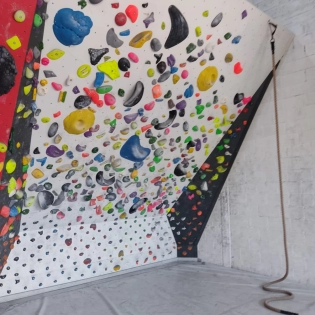Being in shape and having a background in some kind of sport can be a benefit when starting to climb, but, it is not a requirement. Almost anyone, regardless of how fit there are and their weight, can climb.
While you climb, you will probably start to feel muscles that most refer to as "muscles they have never felt before and didn't know existed". This is because climbing utilizes muscles that most people usually do not use that often, at least not in the way climbing uses them. This is especially true for people who do not come from a fitness background of some kind.
Climbing in itself can help you get in shape, but getting in shape also depends on what you do outside the climbing gym or away from the rocks. It has to do with how you treat your body, how often you climb or exercise, if you stretch and work on preventing/treating injuries, and of course on your diet.
Neither are necessarily harder than the other, It depends on the grade of the route you are climbing and your skills as a climber. You could climb a 5A top rope route that would be equally easy as a 5A lead route. You could also climb an 8A top rope route, and it would be just as hard as a lead route.
One element that could make lead climbing harder than top rope is the fact that you have to clip your rope into quickdraws while climbing. To do this, you have to be efficient at clipping, and you have to be efficient at resting, since clipping, although it may take a fraction of a second, can tire the climber out if they are not efficient at clipping or if the route is just very difficult.
On the other hand, many people who top rope and auto belay may find it a little bit tricky to make their way around the rope that is always in front of them, which sometimes could be a hassle, especially if you are on a very difficult route and the rope is in your way, and you have to move it, or yourself, to get to the next hold. This, like with lead climbing, requires technique and skill.
All forms of climbing have their difficulties, there is not necessarily a harder climbing form than another. Many factors come into play with this question, and it depends greatly on the climbers themselves.
While a chalk bag is not a requirement for bouldering or climbing in general, it is highly recommended to use chalk as it can be the difference between sending a route and falling. Chalk, when used, is preferably kept in a chalk bag or a chalk bucket, which is similar to a chalk bag, just larger and usually with more pockets for brushes and other items.
Chalk can be essential for those who sweat from their palms, or that climb with others who sweat, since they may be causing the climbing holds to be more slippery for you as well as for them.
Many people also don't think that they sweat from their palms and that they do not need chalk, but, most don't realize that they sweat even slightly, and that small amount of sweat could be what causes you to slip from a hold and not send the route.
Indoor rock climbing is just called indoor rock climbing. Though, the term could refer to a few different styles of climbing.
Indoor climbing could refer to bouldering, sport climbing, top rope climbing, auto-belay climbing, and speed climbing. Each of these may have similar traits to each other, but they are each different in their own way.
The most common and popular forms of indoor climbing are bouldering and sport climbing. So it is most likely that when referring to indoor rock climbing, it is actually a reference to either indoor bouldering or indoor sport climbing.
Tall and short people both have the potential to become amazing climbers. Climbing does not depend on the climbers height.
There are times when being short can be beneficial, such is in very compressed movements and positions, and there are times when being tall and having a long arm span can be very useful, such as reaching farther holds easier.
The main thing to keep in mind is your technique, and how you take advantage of your height, be it shorter or taller.
Rock climbing is possible in sneakers, and even barefoot for that matter, but it is highly recommended to climb in climbing shoes as they will provide a better base for standing on small climbing holds, and give you better stability and grip on the wall.
Sneaker tend to have very soft rubber for their sole, and a generally inefficient shape and size when it comes to climbing. Due to this, trying to stand on small foot holds may be impossible since sneakers have such a large and soft sole, your feet would just slide right off of them.
Climbing shoes on the other hand have much harder rubber, the shoes are much tighter, and they are much less bulky. They are very thin in comparison to sneakers. All of these attributes, plus their shape, give climbers the best performance possible when it comes to feet work.
In climbing shoes, you can actually feel what you are standing on, this allows you to trust your feet much more than sneakers, which is something that for many is very difficult, but crucial.




